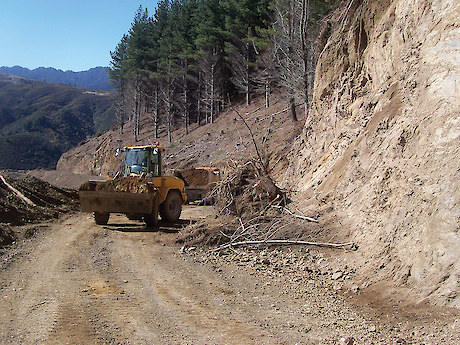 A front-end loader and truck are good for some jobs
A front-end loader and truck are good for some jobs A wheeled excavator with an angled bucket or a smaller tracked excavator with an offset boom is cost effective and versatileMatch as best as possible the available machinery with the maintenance task. This will ensure the job is done to specification, and efficiently. An experienced, trained operator will generally do a more cost-effective and better job. They will also be able to anticipate potential issues that may reduce the amount of future maintenance.
A wheeled excavator with an angled bucket or a smaller tracked excavator with an offset boom is cost effective and versatileMatch as best as possible the available machinery with the maintenance task. This will ensure the job is done to specification, and efficiently. An experienced, trained operator will generally do a more cost-effective and better job. They will also be able to anticipate potential issues that may reduce the amount of future maintenance.
Routine maintenance normally involves the following machinery:
Light grader: Used to reshape the road, grade out any corrugations, ruts, potholes and produce a quality running surface. They can also be used to clear out certain types of ditches
Excavator: Used to excavate any soft spots within the pavement, and to clear out culvert inlets, outlets and ditches. Cleaning out sediment traps can also be completed with an excavator
Gravel trucks: Used to deliver material for replacing soft spots, and to spread gravel over the road replacing any lost running surface material. Bottom dumpers are often used because of their increased accuracy and higher production rate
Front-end loader: The wheeled front-end loader can be a useful maintenance machine, as it can easily travel along road segments thus reducing the amount of transportation required. Used for small excavation jobs, where the material is either loaded onto trucks or transported a short distance by the loader
Rubber tyre roller: Can be either towed or self-propelled. They are used to compact and seal the surface of a pavement that contains well-graded material
Smooth drum steel roller: These can be static or vibrating. They also compact and seal the pavement in situations where there is a high proportion of large material and a small proportion of fines.
Water cart: Used to apply water to the pavement so that compaction can be achieved at optimum moisture content. They can also be used to apply dust control and stabilisation agents.